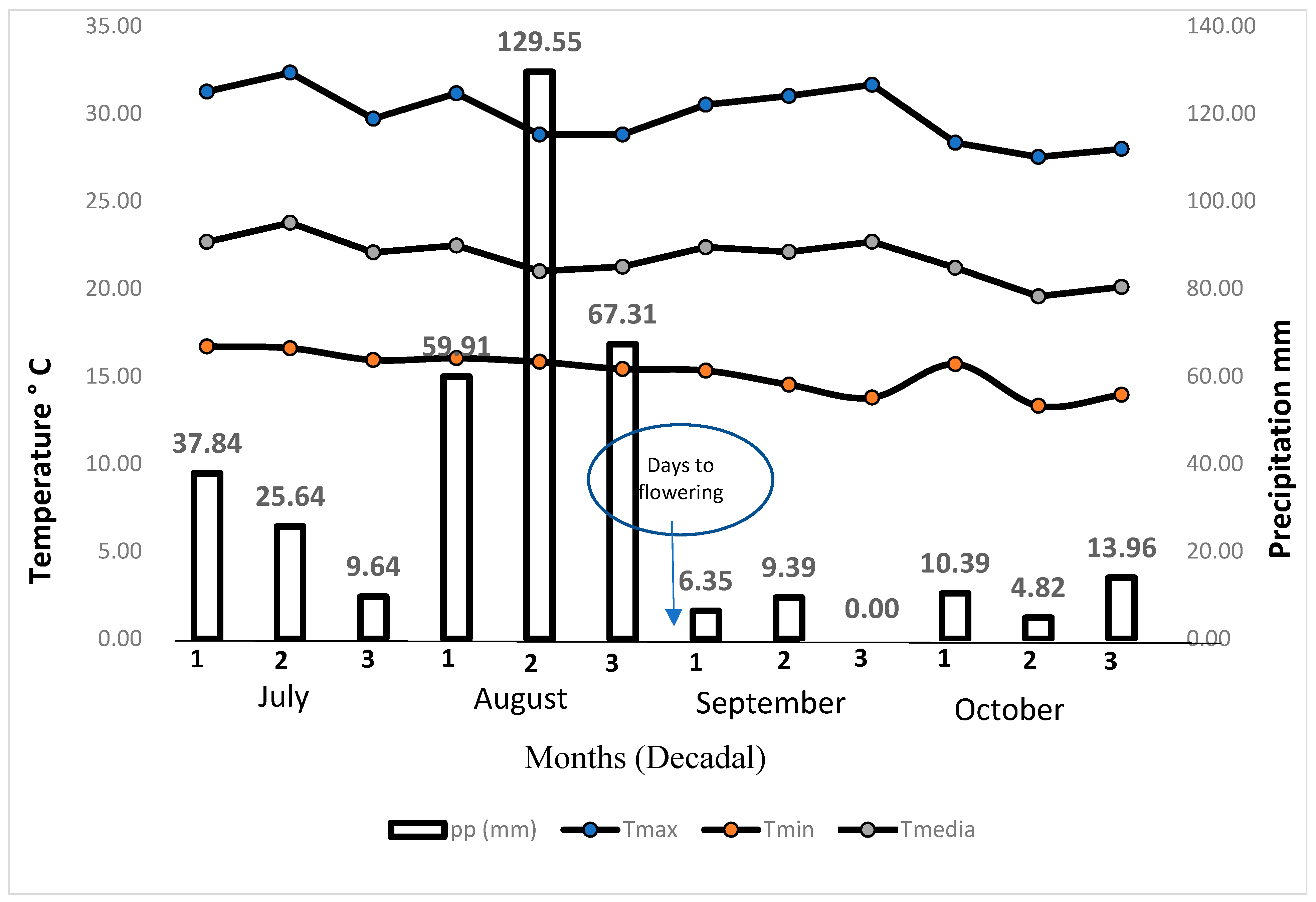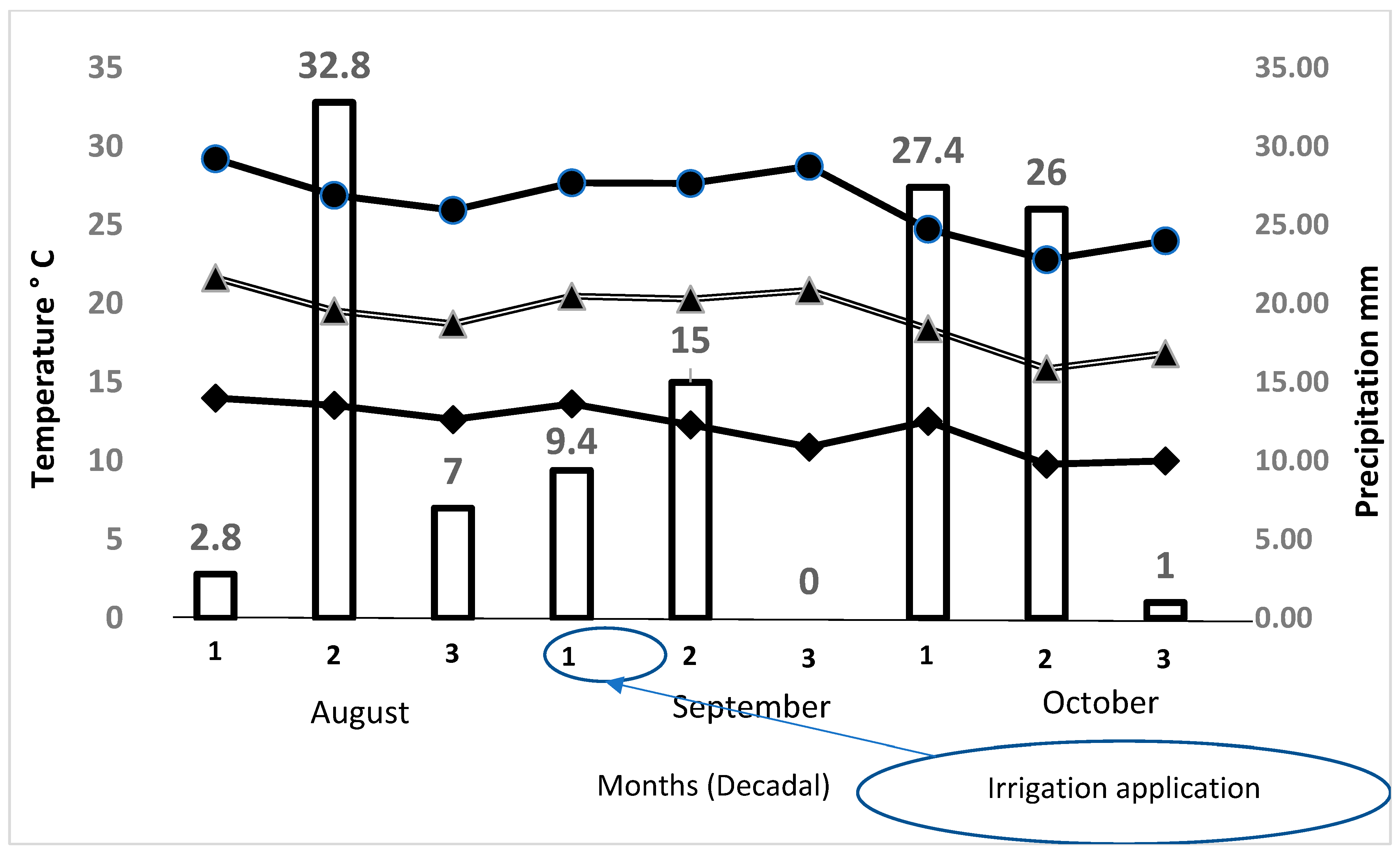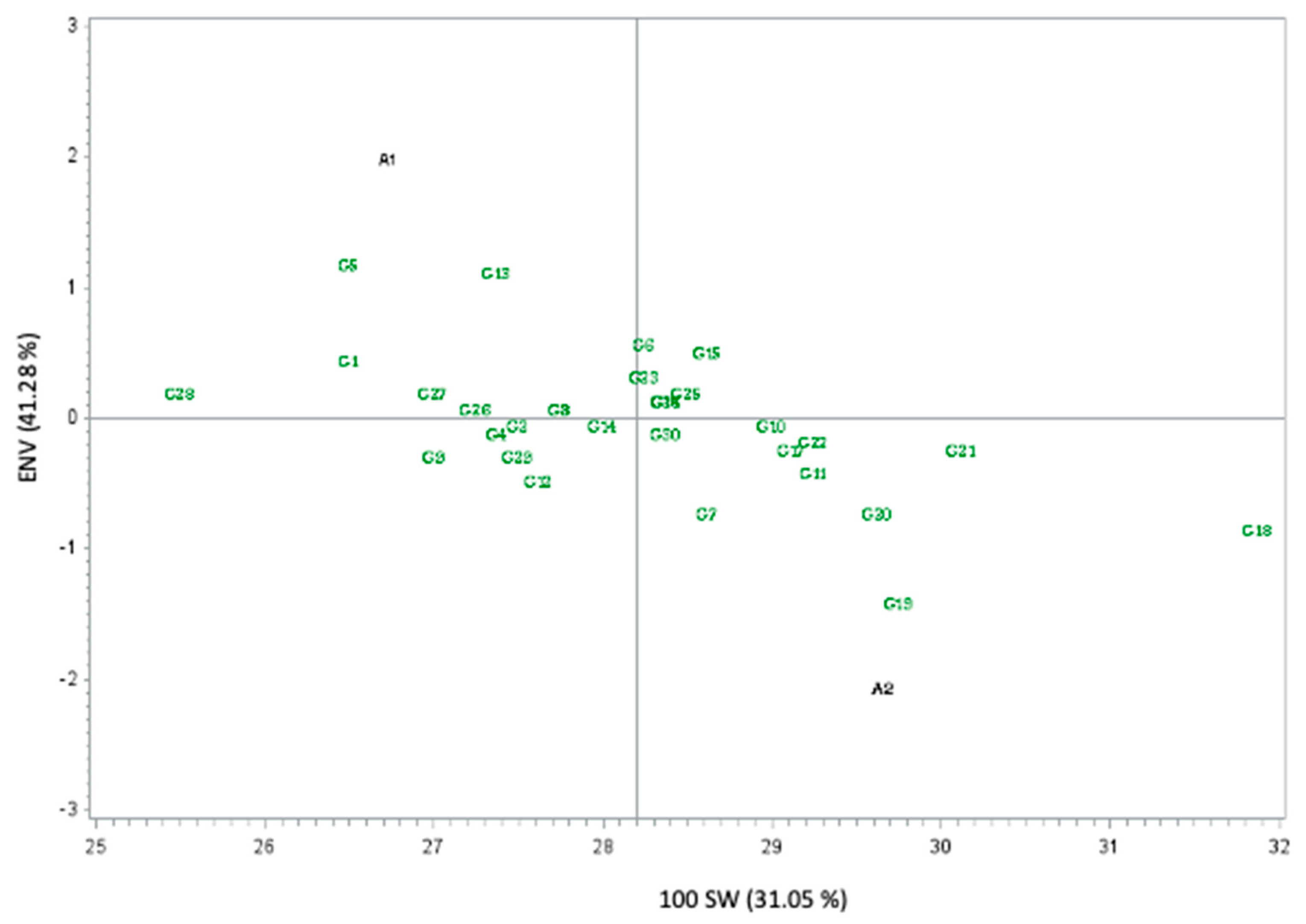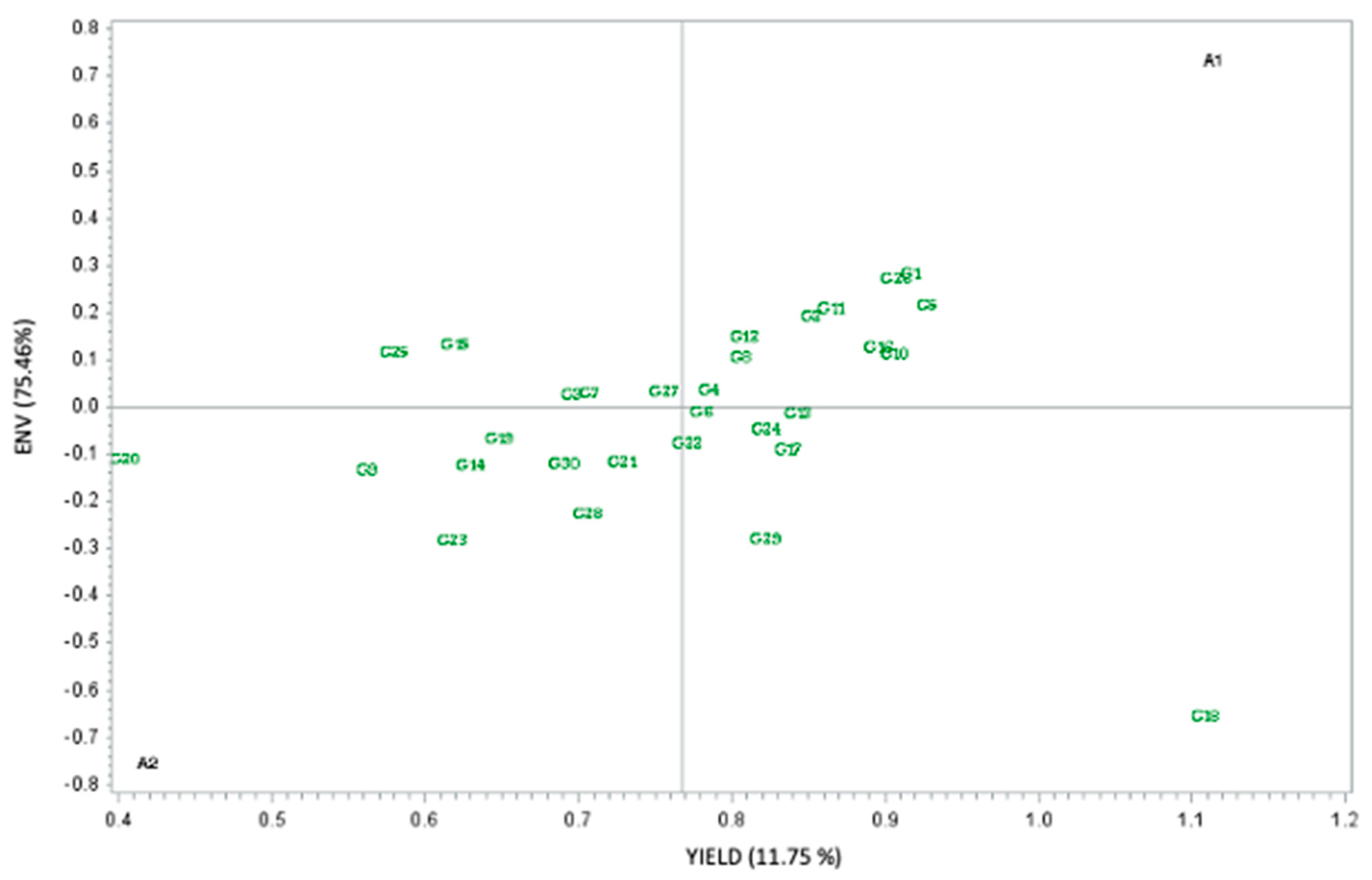Identification of Bean Lines (Phaseolus vulgaris) with Low Genotype–Environment Interactions Under Rainfed in Two Semiarid Sites of North-Central Mexico
Abstract
1. Introduction
2. Materials and Methods
2.1. Ubication
2.2. Germplasm Tested and Experimental Design
2.3. Crop Management
2.4. Statistical Analysis
3. Results
4. Discussion
5. Conclusions
Author Contributions
Funding
Data Availability Statement
Acknowledgments
Conflicts of Interest
References
- SIAP. Secretaria de Agricultura y Desarrollo Rural. Servicio de Información Agroalimentaria y Pesquera. Producción Anual Agrícola. 2022. Available online: https://www.gob.mx/siap/documentos/siacon-ng-161430 (accessed on 10 December 2024).
- Domínguez, S.A.; Darías, R.R.; Yordanys, M.D.Y.; Negrín, E.A. Tolerance of common bean varieties (Phaseolus vulgaris) to field drought conditions. Cent. Agrícola 2019, 46, 22–29. [Google Scholar]
- Acosta-Gallegos, J.A.; Jiménez-Hernández, Y.; Montero-Tavera, V.; Sánchez García, B.M.; Guzmán-Maldonado, S.H. Junio León, nueva variedad de frijol para riego y temporal el altiplano y la mesa central de México. Rev. Mex. De Cienc. Agrícolas 2014, 5, 1369–1374. [Google Scholar]
- Villar, S.B.; López, S.E.; Acosta, G.J.A. Selección de genotipos de frijol por rendimiento y resistencia al mosaico dorado y suelos ácidos. Rev. Fitotec. Mex. 2003, 26, 109–114. [Google Scholar]
- Acosta, J.A.; Acosta, E.; Padilla, S.; Goytia, M.A.; Rosales, R.; López, E. Mejoramiento de la resistencia a la sequía del frijol común en México. Agron. Mesoam. 1999, 10, 83–90. [Google Scholar] [CrossRef]
- Tosquy-Valle, O.H.; Ibarra-Pérez, F.J.; Rodríguez-Rodríguez, J.R.; Esqueda-Esquivel, V.A.; Andrés-Meza, P. Adaptation and disease resistance of elite tropical black bean lines. Legum. Res.—Int. J. 2023, 46, 1126–1133. [Google Scholar] [CrossRef]
- Ganta, T.Y.; Mekbib, F.; Amsalu, B.; Tadele, Z. Genotype by environment interaction and yield stability of drought tolerant mung bean [Vigna radiata (L.) Wilczek] genotypes in Ethiopia. J. Agric. Environ. Sci. 2022, 7, 43–62. [Google Scholar] [CrossRef]
- Rao, P.J.M.; Sandhyakishore, N.; Srinivasan, S.; Sandeep, S.; Praveen, G.; Neelima, G.; Anil Kumar, G. AMMI and gge stability analysis of drought tolerant chickpea (Cicer arietinum L.) genotypes for target environments. Legum. Res.—Int. J. 2023, 46, 1105–1116. [Google Scholar] [CrossRef]
- Ayala-Garay, A.V.; Acosta-Gallegos, J.A.; Reyes-Muro, L. El Cultivo de Frijol Presente y Future para México; Libro Técnico No. 1; INIFAP: Mexico City, Mexico, 2021; 231p. [Google Scholar]
- Cid-Rios, J.A.; Reveles-Hernández, M.; Sánchez-Gutiérrez, R.A.; Echavarría-Cháirez, F.G.; Ramirez-Cabral, N.Y.Z. Fertilización del Cultivo de Frijol de Temporal en Zacatecas; Folleto para Productores No. 45; INIFAP: Mexico City, Mexico, 2023; 30p. [Google Scholar]
- Zobel, R.W.; Wright, M.J.; Gauch, H.G. Statistical analysis of a yield trial. Agron. J. 1988, 80, 388–393. [Google Scholar] [CrossRef]
- SAS Institute Inc. SAS/STAT 9.4; SAS Institute Inc.: Cary, NC, USA, 2011. [Google Scholar]
- Arellano-Arciniega, S.; Osuna-Ceja, E.S.; Martínez-Gamiño, M.A.; Reyes-Muro, L. Rendimiento de frijol fertilizado con estiércol de bovino en condiciones de secano. Rev. Fitotec. Mex. 2015, 38, 313–318. [Google Scholar] [CrossRef]
- Yan, W.; Tinker, N.A. Biplot analysis of multi-environment trial data: Principles and applications. Can. J. Plant Sci. 2006, 86, 623–645. [Google Scholar] [CrossRef]
- White, J.W.; Castillo, J.A.; Ehleringer, J.R.; Garcia, C.J.A.; Singh, S.P. Relations of carbon isotope discrimination and other physiological traits to yield in common bean (Phaseolus vulgaris) under rainfed conditions. J. Agric. Sci. 1994, 122, 275–284. [Google Scholar] [CrossRef]
- Yan, W. Singular-value partitioning in biplot analysis of multi-environment trial data. Agron. J. 2002, 94, 990–996. [Google Scholar]
- Singh, S.P.; Gepts, P.; Debouck, D.G. Races of common bean (Phaseolus vulgaris, Fabaceae). Econ. Bot. 1991, 45, 379–396. [Google Scholar] [CrossRef]
- Ashango, Z.; Amsalu, B.; Tumisa, K.; Negash, K.; Fikre, A. Seed Yield Stability and Genotype x Environment Interaction of Common Bean (Phaseolus vulgaris L.) Lines in Ethiopia. Int. J. Plant Breed. Crop Sci. 2025, 3, 135–144. [Google Scholar]
- Ligarreto-Moreno, G.; Pimentel-Ladino, C. Grain yield and genotype x environment interaction in bean cultivars with different growth habits. Plant Prod. Sci. 2022, 25, 232–241. [Google Scholar] [CrossRef]
- Okii, D.; Mukankusi, C.; Sebuliba, S.; Tukamuhabwa, P.; Tusiime, G.; Talwana, H.; Odong, T.; Namayanja, A.; Paparu, P.; Nkalubo, S.; et al. Genetic variation, Heritability estimates and GXE effects on yield traits of Mesoamerican common bean (Phaseolus vulgaris L.) germplasm in Uganda. Plant Genet. Resour. Charact. Util. 2018, 16, 237–248. [Google Scholar] [CrossRef]
- Darkwa, K.; Ambachew, D.; Mohammed, H.; Asfaw, A.; Blair, M.W. Evaluation of common bean (Phaseolus vulgaris L.) genotypes for drought stress adaptation in Ethiopia. Crop J. 2016, 4, 367–376. [Google Scholar] [CrossRef]
- Schneider, K.A.; Brothers, M.E.; Kelly, J.D. Marker-assisted selection to improve drought resistance in common bean. Crop Sci. 1997, 37, 51–60. [Google Scholar] [CrossRef]
- Rosales-Serna, R.; Ramírez-Vallejo, P.; Acosta-Gallegos, J.A.; Castillo-González, F.; Kelly, J.D. Rendimiento de grano y tolerancia a la sequía del frijol común en condiciones de campo. Agrociencia 2000, 34, 153–165. [Google Scholar]
- Kelly, J.D.; Kolkman, J.D.; Schneider, K. Breeding for yield in dry bean (Phaseolus vulgaris L.). Euphytica 1998, 102, 343–356. [Google Scholar] [CrossRef]




| Líne | Genealogy | DF | DM | DPR | 100SW | Seed Yield (kg ha−1) | WUE |
|---|---|---|---|---|---|---|---|
| (g) | (kg mm−1) | ||||||
| 1 | GPO82 82 FJ22-1 | 46 | 83 | 37 | 26 | 1484 | 3.97 |
| 2 | GPO82 82 FJ22-2 | 48 | 81 | 33 | 26 | 1352 | 3.67 |
| 3 | GPO82 82 FJ22-3 | 49 | 82 | 33 | 26.1 | 1071 | 3.07 |
| 4 | GPO82 82 FJ22-4 | 48 | 82 | 34 | 25.8 | 1168 | 3.36 |
| 5 | GPO82 82 FJ22-6 | 48 | 82 | 34 | 27.3 | 1444 | 3.98 |
| 6 | GPO61 36 | 47 | 84 | 37 | 27.8 | 1128 | 3.24 |
| 7 | GPO59 67 | 50 | 83 | 33 | 25.5 | 1087 | 3.18 |
| 8 | GPO82 NO82-1 FJ35-2 | 49 | 85 | 36 | 26.3 | 1042 | 3.31 |
| 9 | GPO82 NO82-1 FJ35-1 | 49 | 82 | 33 | 25.1 | 820 | 2.28 |
| 10 | GPO61 36 | 48 | 83 | 35 | 27.3 | 1347 | 3.67 |
| 11 | GPO61 36 | 47 | 84 | 37 | 27 | 1178 | 3.46 |
| 12 | GPO61 36 | 47 | 85 | 38 | 24.9 | 1115 | 3.28 |
| 13 | GPO61 36 | 47 | 85 | 38 | 27.9 | 1190 | 3.59 |
| 14 | GPO61 36 | 47 | 84 | 37 | 26.3 | 895 | 2.39 |
| 15 | FJD121-6 | 47 | 85 | 38 | 28.3 | 1074 | 2.66 |
| 16 | FJD121-5 | 47 | 86 | 39 | 26.9 | 1189 | 3.71 |
| 17 | FJD121-4 | 49 | 86 | 37 | 86.6 | 1127 | 2.92 |
| 18 | FJD121-3 | 50 | 84 | 34 | 28.3 | 977 | 2.67 |
| 19 | FJD121-2 | 48 | 84 | 36 | 25.1 | 954 | 2.43 |
| 20 | FJD121-1 | 49 | 84 | 35 | 26.5 | 678 | 2.01 |
| 21 | FJD121-7 | 50 | 86 | 36 | 27.8 | 997 | 2.77 |
| 22 | FJD121-8 | 49 | 87 | 38 | 27.1 | 1069 | 2.99 |
| 23 | FJD121-9 | 49 | 87 | 38 | 27.3 | 764 | 1.99 |
| 24 | FJD121-10 | 50 | 86 | 36 | 26.9 | 1143 | 3.07 |
| 25 | FJDGPO61 36 | 49 | 85 | 36 | 27.4 | 1023 | 2.44 |
| 26 | Junio León (C) | 49 | 86 | 37 | 26 | 1295 | 3.96 |
| 27 | Dalia (C) | 47 | 86 | 39 | 25.9 | 1137 | 3.19 |
| 28 | FJD124-3 | 46 | 85 | 39 | 24.2 | 894 | 2.13 |
| 29 | FJD124-2 | 48 | 83 | 35 | 25.2 | 971 | 2.58 |
| 30 | FJD124-1 | 48 | 82 | 34 | 26.4 | 958 | 2.07 |
| Mean | 48 | 84 | 36 | 28.5 | 1086 | 3.00 |
| Líne | Genealogy | DF | DM | DPR | 100SW | Seed Yield | WUE | |
|---|---|---|---|---|---|---|---|---|
| (g) | (kg ha−1) | (kg mm−1) | ||||||
| 1 | GPO82 82 FJ22-1 | 33 | 75 | 42 | 27 | 352 | bcd | 1.43 |
| 2 | GPO82 82 FJ22-2 | 37 | 75 | 38 | 29 | 355 | bcd | 1.44 |
| 3 | GPO82 82 FJ22-3 | 35 | 76 | 41 | 29 | 323 | bcd | 1.34 |
| 4 | GPO82 82 FJ22-4 | 31 | 76 | 45 | 29 | 406 | bcd | 1.38 |
| 5 | GPO82 82 FJ22-6 | 42 | 74 | 32 | 26 | 414 | bcd | 1.26 |
| 6 | GPO61 36 | 41 | 75 | 34 | 29 | 435 | bcd | 1.70 |
| 7 | GPO59 67 | 40 | 73 | 33 | 32 | 332 | bcd | 1.32 |
| 8 | GPO82 NO82-1 FJ35-2 | 34 | 76 | 42 | 29 | 374 | bcd | 1.50 |
| 9 | GPO82 NO82-1 FJ35-1 | 31 | 76 | 45 | 29 | 307 | bcd | 1.09 |
| 10 | GPO61 36 | 35 | 76 | 41 | 31 | 468 | bcd | 1.37 |
| 11 | GPO61 36 | 38 | 72 | 34 | 32 | 356 | bcd | 1.35 |
| 12 | GPO61 36 | 33 | 74 | 41 | 30 | 344 | bcd | 1.37 |
| 13 | GPO61 36 | 42 | 75 | 33 | 27 | 500 | bcd | 1.87 |
| 14 | GPO61 36 | 37 | 74 | 37 | 30 | 367 | bcd | 1.45 |
| 15 | FJD121-6 | 34 | 76 | 42 | 29 | 168 | cd | 0.68 |
| 16 | FJD121-5 | 42 | 76 | 34 | 30 | 448 | bcd | 1.99 |
| 17 | FJD121-4 | 36 | 74 | 38 | 31 | 551 | b | 2.21 |
| 18 | FJD121-3 | 38 | 74 | 36 | 35 | 1243 | a | 4.76 |
| 19 | FJD121-2 | 32 | 74 | 42 | 34 | 345 | bcd | 1.46 |
| 20 | FJD121-1 | 30 | 75 | 45 | 33 | 133 | d | 0.55 |
| 21 | FJD121-7 | 41 | 75 | 34 | 32 | 463 | bcd | 1.90 |
| 22 | FJD121-8 | 37 | 76 | 39 | 31 | 476 | bcd | 2.02 |
| 23 | FJD121-9 | 41 | 72 | 31 | 29 | 474 | bcd | 1.89 |
| 24 | FJD121-10 | 37 | 76 | 39 | 30 | 504 | bcd | 1.94 |
| 25 | FJDGPO61 36 | 31 | 76 | 45 | 30 | 140 | d | 0.58 |
| 26 | Junio León (C) | 36 | 75 | 39 | 29 | 351 | bcd | 1.28 |
| 27 | Junio Dalia (C) | 37 | 74 | 37 | 28 | 379 | bcd | 1.43 |
| 28 | FJD124-3 | 42 | 75 | 33 | 27 | 521 | bc | 2.08 |
| 29 | FJD124-2 | 34 | 75 | 41 | 30 | 677 | b | 2.55 |
| 30 | FJD124-1 | 34 | 70 | 36 | 30 | 427 | bcd | 1.84 |
| Mean | 36 | 75 | 38 | 30 | 421 | 1.63 |
| Líne | 100SW (g) | Líne | 100SW (g) | Líne | 100SW (g) | Líne | 100SW (g) | Líne | 100SW (g) |
|---|---|---|---|---|---|---|---|---|---|
| 18 | 31.63a | 17 | 29bcde | 16 | 28.20bcde | 3 | 27.56bcdef | 13 | 27.19bcdef |
| 21 | 29.89ab | 10 | 28.91bcde | 24 | 28.19bcde | 2 | 27.5bcdef | 9 | 27.05cdef |
| 19 | 29.56abc | 15 | 28.63bcde | 6 | 28.16bcde | 12 | 27.45bcdef | 27 * | 26.95cdef |
| 20 | 29.5abc | 7 | 28.5bcde | 23 | 28.13bcde | 4 | 27.38bcdef | 1 | 26.5def |
| 11 | 29.25abcd | 25 | 28.44bcde | 14 | 27.91bcdef | 29 | 27.35bcdef | 5 | 26.39ef |
| 22 | 29.06bcd | 30 | 28.21bcde | 8 | 27.63bcdef | 26 * | 27.26bcdef | 28 | 25.36f |
| Líne | Yield (kg ha−1) | Líne | Yield (kg ha−1) | Líne | Yield (kg ha−1) | Líne | Yield (kg ha−1) | Líne | Yield (kg ha−1) |
|---|---|---|---|---|---|---|---|---|---|
| 18 | 1.110a | 11 | 0.866abc | 12 | 0.8091abc | 21 | 0.7291bcd | 14 | 0.630bcd |
| 5 | 0.928ab | 2 | 0.853abc | 8 | 0.8069abc | 7 | 0.7085bcd | 15 | 0.621bcd |
| 1 | 0.918abc | 13 | 0.844abc | 4 | 0.7863abc | 28 | 0.7069bcd | 23 | 0.619bcd |
| 26 * | 0.908abc | 17 | 0.838abc | 6 | 0.7811abc | 3 | 0.6965bcd | 25 | 0.581bcd |
| 10 | 0.907abc | 24 | 0.823abc | 22 | 0.7721abc | 30 | 0.6915bcd | 9 | 0.563cd |
| 16 | 0.897abc | 29 | 0.823abc | 27* | 0.7571abc | 19 | 0.6493bcd | 20 | 0.405d |
Disclaimer/Publisher’s Note: The statements, opinions and data contained in all publications are solely those of the individual author(s) and contributor(s) and not of MDPI and/or the editor(s). MDPI and/or the editor(s) disclaim responsibility for any injury to people or property resulting from any ideas, methods, instructions or products referred to in the content. |
© 2025 by the authors. Licensee MDPI, Basel, Switzerland. This article is an open access article distributed under the terms and conditions of the Creative Commons Attribution (CC BY) license (https://creativecommons.org/licenses/by/4.0/).
Share and Cite
Cid-Ríos, J.Á.; Acosta-Gallegos, J.A.; Echavarría-Cháirez, F.G.; Bañuelos-Valenzuela, R.; Prado-García, A.A. Identification of Bean Lines (Phaseolus vulgaris) with Low Genotype–Environment Interactions Under Rainfed in Two Semiarid Sites of North-Central Mexico. Agronomy 2025, 15, 1160. https://doi.org/10.3390/agronomy15051160
Cid-Ríos JÁ, Acosta-Gallegos JA, Echavarría-Cháirez FG, Bañuelos-Valenzuela R, Prado-García AA. Identification of Bean Lines (Phaseolus vulgaris) with Low Genotype–Environment Interactions Under Rainfed in Two Semiarid Sites of North-Central Mexico. Agronomy. 2025; 15(5):1160. https://doi.org/10.3390/agronomy15051160
Chicago/Turabian StyleCid-Ríos, José Ángel, Jorge Alberto Acosta-Gallegos, Francisco Guadalupe Echavarría-Cháirez, Rómulo Bañuelos-Valenzuela, and Alejandro Antonio Prado-García. 2025. "Identification of Bean Lines (Phaseolus vulgaris) with Low Genotype–Environment Interactions Under Rainfed in Two Semiarid Sites of North-Central Mexico" Agronomy 15, no. 5: 1160. https://doi.org/10.3390/agronomy15051160
APA StyleCid-Ríos, J. Á., Acosta-Gallegos, J. A., Echavarría-Cháirez, F. G., Bañuelos-Valenzuela, R., & Prado-García, A. A. (2025). Identification of Bean Lines (Phaseolus vulgaris) with Low Genotype–Environment Interactions Under Rainfed in Two Semiarid Sites of North-Central Mexico. Agronomy, 15(5), 1160. https://doi.org/10.3390/agronomy15051160






